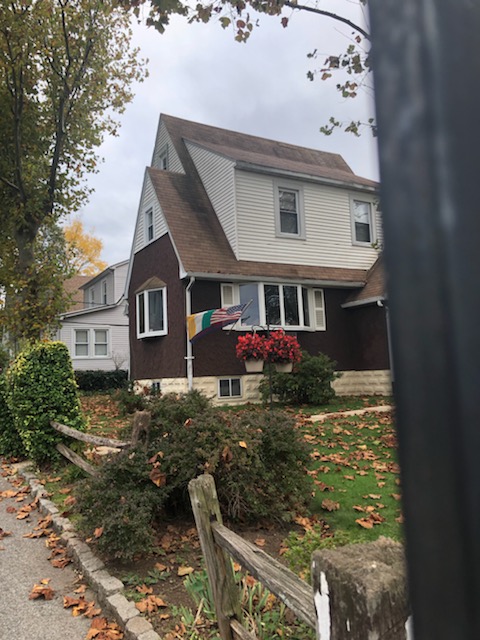New York Neighborhoods: An Autumn Day in Throgs Neck
A unique Irish-American combination flag hangs outside a Silver Beach home, an area of the Throggs Neck neighborhood of the Bronx.
If you take Vallo from Queens, you have likely passed through Throgs Neck hundreds of times.
When I asked fellow Bronx Science students their opinions about Throgs Neck, most gave me answers similar to Anindita Das ’23, who characterized the area as “a nice quiet neighborhood.”
But is there more to Throgs Neck than its tranquility?
My grandma lives in Throgs Neck, so I am there all the time; not only do I love it dearly for that reason, but it is also a cool place in general. Jessica Tiburco, a Bronx resident, had plenty of compliments for the community. Tiburco enjoys “that people get into the holiday spirit and people will decorate their front doors.” She also appreciates “the fact that there are buses that can take you to the Bronx, to Queens and even the express bus into the city in less than thirty minutes.”
My seventh-grade English teacher, Lauren Rae-Romero, had similar thoughts to share. She values that “going to Throgs Neck feels like stepping away from New York City.” She adds that “there are lots of locally owned restaurants to visit.”
Despite this, travel tips online for Throgs Neck are at best sparse and vague. With this in mind, I decided to investigate the area for myself by spending an autumn day in Throgs Neck.
My parents and I started our trip by car. That was the easiest way for us, although a number of buses do service the peninsular, Southeast Bronx neighborhood.
We first ventured into Old St. Raymond’s Cemetery. My grandfather is buried in this graveyard, so I go there all the time, but it never fails to amaze me. It is massive and labyrinthine, notable for its old graves, elaborate mausoleums, and a beautifully manicured lawn. In the fall it is especially pretty, because when the trees blow down their leaves, the ground is dotted with festive autumn colors. Most of the surnames carved on the graves are Irish and Italian, which makes sense considering the demographic composition of the neighborhood.
There are a number of famous people buried in the cemetery. We first visited the grave of Father Duffy, the namesake of Father Duffy Square. A Catholic priest of Irish descent, Father Duffy served in the United States military and became the most decorated chaplain in American history. His gravestone — an intricate Celtic cross, decorated by passersby with Irish, American, and Canadian flags (he was born in Canada before moving to America) and a stone summarizing his achievements — was accordingly impressive.
A little ways further we came upon a memorial for those who lost their lives fighting for the IRA — the Irish Republican Army. The IRA was an unofficial military force in Ireland; its goal was to free Ireland from British rule. Most of the text is written in English, but it concludes with an Irish phrase: “Go ndéana Dia trócaire orthu,” which translates into English as “May God have mercy on them.”
It took time to navigate the organizational system of the cemetery, but we finally came to the last grave that we wanted to look at, that of Mary Mallon, commonly known as “Typhoid Mary.” This infamous Irish immigrant was a super-spreader of typhoid in the nineteenth century. I wanted to visit her gravestone because, in light of the COVID-19 pandemic, her story has striking parallels with modern times.
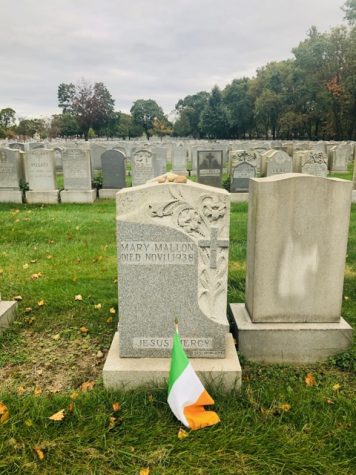
Her notoriety, however, was not reflected in her gravestone; it was rather simple, plainly adorned by two stones— three, if counting the one that I placed on top — and an Irish flag.
The journey to our next destination was noteworthy in its own way. We ended up passing many institutions of the neighborhood: St. Joseph’s School for the Deaf; Monsignor Scanlan High School; Brewski’s, an Irish bar with a catchy side mural; Marina Del Rey, an event venue by the water; a number of ethnic beach clubs; and innumerable Irish, Italian and American flags, mixed in with a few Albanian and Irish-American combination flags.
We ultimately stopped at Preston, an all-girls Catholic high school in the neighborhood. Modern infrastructural additions have been made to Jennifer Lopez’s — and my aunt’s — alma mater, but the original building remains intact, and it has a fascinating history. When Throgs Neck was a waterside haven for wealthy families, the building that is now part of Preston was a mansion owned by Collis P. Huntington, an Industrial Revolution-era railroad tycoon. Today, the area is mainly composed of middle-class Irish-American, Italian-American, and Puerto Rican-American families, but the continued presence of Huntington Mansion is an interesting throwback to what Throgs Neck once was.
Throgs Neck is unique in that it is composed of a number of sub-neighborhoods. Leaving Preston we passed such a community, Silver Beach, a co-op community. Another co-op community in Throgs Neck is Edgewater Park, although we did not pass that part of the area on our trip.
We ultimately visited SUNY Maritime, a college located in the Locust Point subsection of the neighborhood. It borders the water and has breathtaking views of the Whitestone Bridge, the Throgs Neck Bridge, Queens, and the Manhattan skyline.
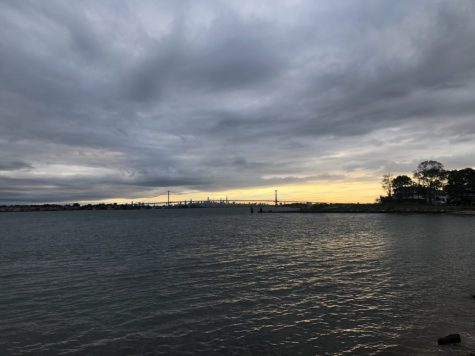
Near SUNY Maritime, we saw a sign directing drivers onto the Throgs Neck Bridge, and it brought up a question for my parents and myself that has yet to be resolved: what is the correct way to spell the name of this neighborhood?
Locals generally agree that the neighborhood is spelled “Throggs Neck,” but New York City bureaucrats, academics, and journalists typically spell the neighborhood in relevant material as “Throgs Neck.” Robert Moses, the ruthless New York infrastructure planner of the twentieth century, is the reason for this discrepancy; he cut off the second ‘g’ in “Throggs” when he was building the Throgs Neck Bridge, in order to cut costs.
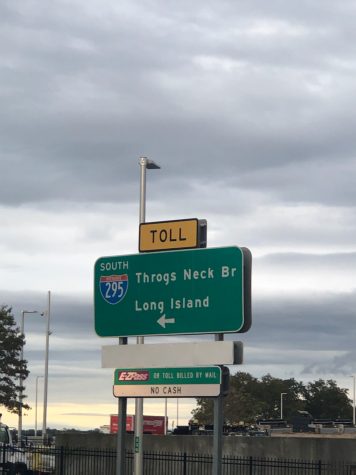
By the time my parents and I finished visiting SUNY Maritime, the sun was setting, and I was hungry. We drove to Louie & Ernie’s, an iconic pizza parlor located on the fringes of the neighborhood. I had a plain slice, although I highly recommend their eggplant pizza.
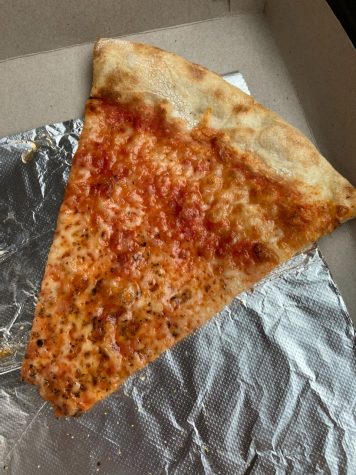
We ended our trip in Schuylerville, another subsection of Throgs Neck; this is where the main retail strip, as well as my Grandma’s house, is located. We went shopping at Foodtown, and, in the spirit of being in Throgs Neck, I bought Italian cookies.
My Grandma and I snacked on them as we watched the leaves fall outside of her house and I told her all about my day in her neighborhood.
“Travel tips online for Throgs Neck are at best sparse and vague. With this in mind, I decided to investigate the area for myself by spending an autumn day in Throgs Neck.”
Johanna Doyle is the Senior Facebook Editor of The Science Survey. She finds both journalistic writing and photography to be appealing because they capture...
Johannah Doyle is the Junior 'Science Survey' FaceBook Editor and also a Staff Reporter for 'The Science Survey.' She finds journalistic writing and photography...

